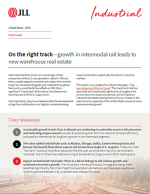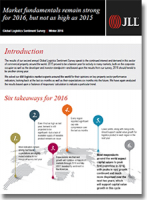2015 Seaport Outlook
TEUs are shifting and industrial occupancy is healthy across North American seaports.
The JLL North America Seaport Outlook provides a distinctive analysis of seaport-centric industrial space in gateway real estate markets.
Observing the influence of global economic drivers, including trade and cargo flows, socioeconomic and political factors, as well as port capacity and infrastructure investment, it provides both a macro overview of current trends impacting the domestic sector in addition to detailed information on major seaports.
This report explores industrial property fundamentals in a 15-mile radius from seaports, given a minimum building size of 50,000 square feet.
Key takeaways
- Market share shifts east: Shippers continue to diversify how goods enter and leave the country as a way to mitigate potential supply chain disruptions. What was once a 61.2 percent TEU market share for West Coast ports in 2007 has since declined to 55.2 percent.
- Industrial occupancy is healthy on both coasts: West Coast seaport markets had a collective occupancy increase of 2.2 percent in 2014 compared to 2007, while Gulf/East Coast markets were up 4.4 percent over the same time period.
- Not all industrial markets are created equal: Many older seaports are constrained by the cities that built up around them, and not all available facilities are viable options for today’s industrial users. Lack of functioning obsolescence can be an issue - this can put upward pressure on rents for quality, relevant space in markets like New York / New Jersey, Los Angeles and Oakland
- There are different types of cargo: Much of the highly publicized cargo shift to the eastern seaboard is discretionary (goods not destined for local consumption, but can move through any entry point of the shipper’s choosing). At the end of the day, seaport markets based in notable population centers are faring well: It’s a matter of where goods ultimately end up rather than where they enter the continent
- New York, New York: The Port of New York / New Jersey, for the fourth consecutive year, outranks all other seaports based on JLL’s PAGI scoring methodology. 2014 TEU volume was up 40.9 percent from 2007, and several large block availabilities – albeit, in generally older facilities – offer options to industrial users. New infill development will help satisfy demand for modern space
- Two and three: Long Beach and Los Angeles round out our top three. Industrial vacancy in both markets is under 4.0 percent, and their collective TEU volume is 2.5x that of New York / New Jersey. They are anticipated to remain the primary gateway into the United States in the years to come based on their infrastructure, automation enhancements and strong rail connectivity to interior U.S. markets
- Savannah, Charleston and Virginia are well-positioned: An expanded Panama Canal is scheduled to debut in the first half of 2016, and these ports – along with New York / New Jersey – offer access to battleground, densely populated regions. Each has strong rail connections, and more West Coast discretionary cargo will likely call on these ports
- Eighty-seven percent: of the world’s fleet, in terms of total TEU capacity, will be able to traverse the new Panama Canal, according to the Journal of Commerce. Additionally, as much as 10.0 percent of container traffic between East Asia and the United States could shift from U.S. West Coast ports to their eastern seaboard counterparts by 2020, according to research from The Boston Consulting Group and C.H. Robinson. Although the aforementioned East Coast ports may receive increased TEU traffic, it cannot be assumed that demand for warehouse space will transfer equally. There are too many complexities and variables (freight rail costs, intermodal, automation, etc.) in the movement of goods to portend a macro shift in industrial occupancy from the West Coast to eastern seaboard markets.
Log in to download this paper.
What’s Related
News





Supply Chain Challenges with Rich Thompson, Jones Lang LaSalle
In this podcast, Jeff Berman, Group News Editor for Logistics Management and the Peerless Media Supply Chain Group, interviews Rich Thompson, International Director, JLL Supply Ch...
Intermodal Growth Starting to Pay Off with Inland Ports’ Development
9 Attributes Redefining the Warehouse of the Future
Logistics and the Sharing Economy
Logistics Management 33rd Annual Salary Survey
More News
Resources

Growth in Intermodal Rail Leads to New Warehouse Real Estate
Trucking is by far the predominant mode of shipping in the U.S., but it has its constraints, from driver shortages to escalating costs and roadway congestion, and while freight mat...

Global Logistics Sentiment Survey 2016
Jones Lang LaSalle (JLL) culled feedback and opinions from 659 global logistics market experts on key property sector performance indicators by taking a look at the last six months...

Are You Ready to Enter the Global E-Commerce Markets?
In this white paper, we establish the overall dynamics, the rapid evolution, and finally the impact of e-commerce on the industrial sector and emergence of 'logistics' and 'distrib...
More Resources
Favorites

How Does IKEA’s Inventory Management Supply Chain Strategy Really Work?
Each IKEA store is huge and holds more than 9,500 products! How in the world does IKEA offer so...

Starbucks as an Example of the Value Chain Model
The concept of value chain helps to understand and segregate the useful (which help in gaining a competitive...

7 Principles of Supply Chain Management Explained
Would you like to understand supply chain management concepts but don't have time to study from a textbook?...

Is Apple’s Supply Chain Really the No. 1? A Case Study
How Complex is Apple's Supply Chain? Some people in the blogosphere said that Apple's Supply Chain is not...

